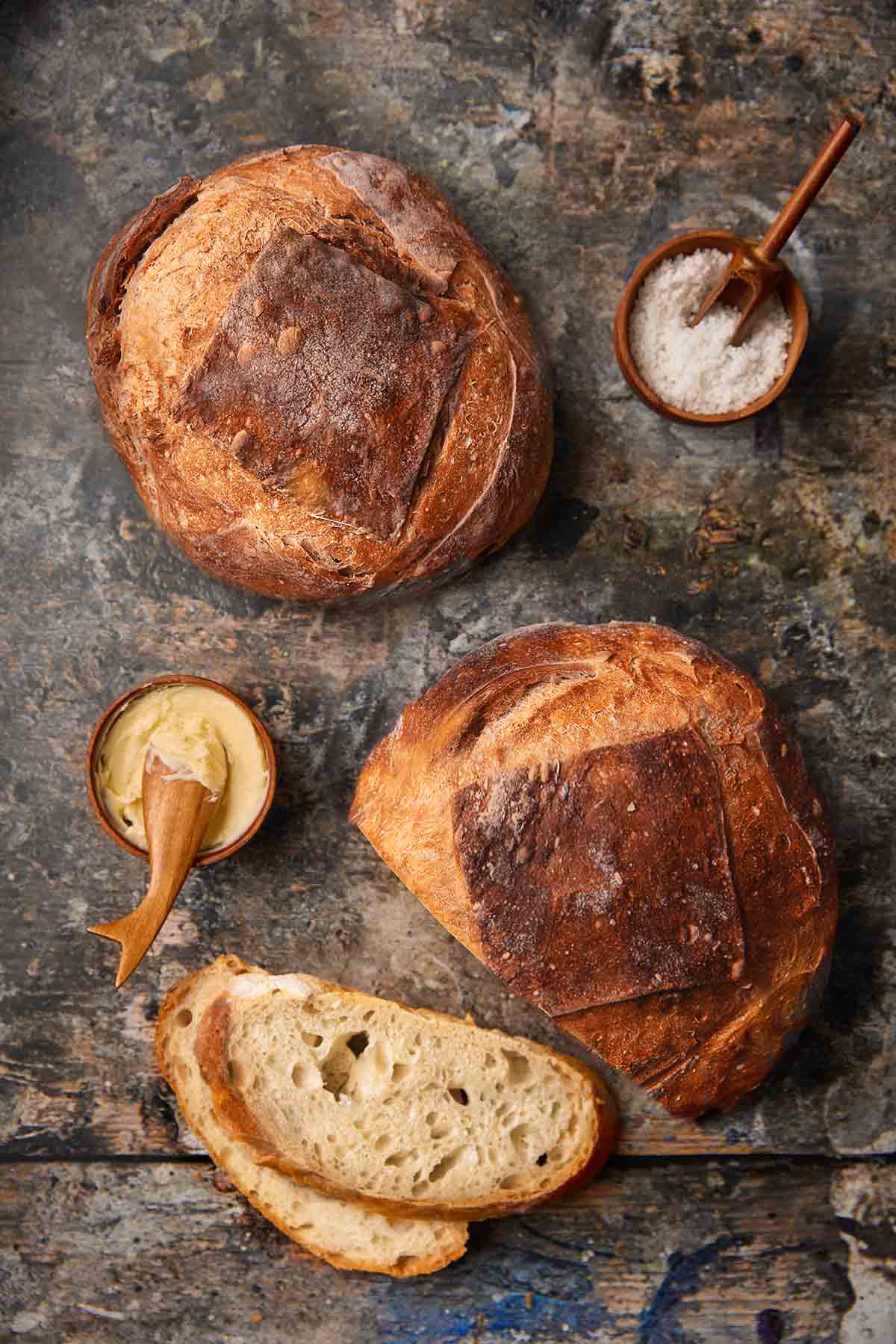
This 5-minute no-knead artisan bread recipe is truly “revolutionary.” That’s the word the authors who created this quick homemade bread recipe use to describe it, and we couldn’t agree more. Like so many rustic bread recipes, it relies on just pantry staples of all-purpose flour, yeast, salt, and water. But what distinguishes this recipe, its true genius, is the technique. There’s no kneading required.
More than that, though, you can stash it in the fridge for later. So you simply forget about it until you’re overtaken by the craving for freshly baked bread. When that happens, you just grab the dough from the fridge, lop off enough for a loaf, shape it, let it rest a few moments, and then slide it in the oven before you continue to go about your life. We’re talking 5 minutes of effort here. Seriously. Just don’t forget to come back later to retrieve the best loaf of artisan bread you’ve ever experienced from the oven.
Jump To

Why This Recipe Works
This no-knead bread works because it cleverly relies on a long, slow rise in the refrigerator to develop flavor and gluten. This eliminates the need for kneading, making it wicked convenient.
The high baking temperature and added steam create a crisp, golden crust. It’s the perfect combination of ease and artisan quality, yielding a fantastic loaf with minimal effort. That’s so Zoë!
Notes on Ingredients
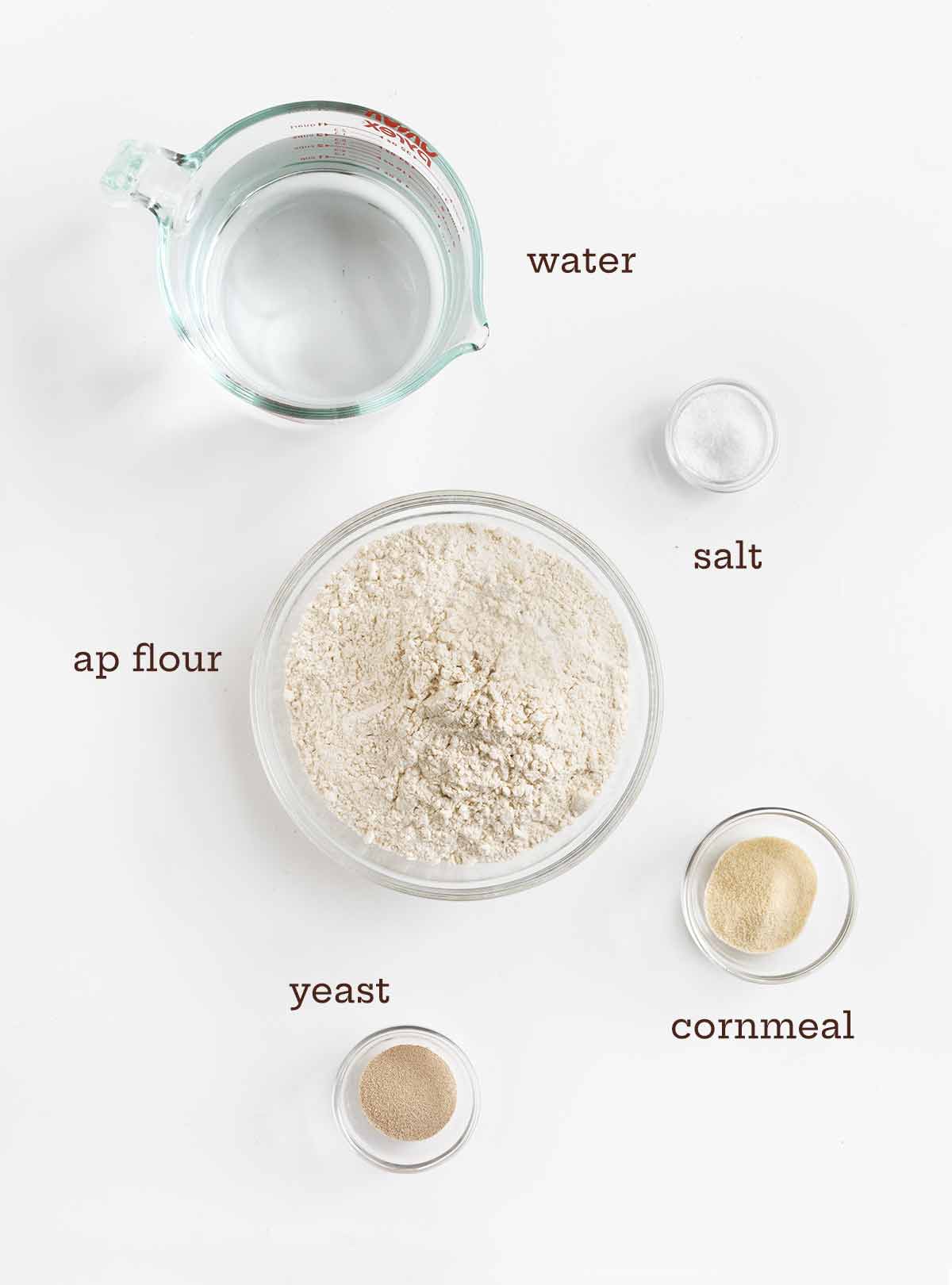
- Water–This serves two purposes in the recipe: first, to hydrate your bread dough, and second, to create steam in the oven during baking. The steam is imperative for creating a crisp crust on your bread.
- Yeast–Any type of yeast you’ve got on hand will work for this recipe, whether it’s regular, quick-rise, instant, or bread machine. If you haven’t used your yeast in a while and want to make sure it’s still active, mix 2 1/4 teaspoons of the yeast with 1/4 cup of warm water and 1 teaspoon of sugar. Active yeast will bubble and foam within 10 minutes.
- Flour–Regular all-purpose flour works best here.
- Salt–Use a coarse style of salt for this bread, such as kosher salt. Don’t be tempted to reduce the amount of salt, as it plays a critical role in maintaining the stability of your bread.
How to Make Artisan Bread
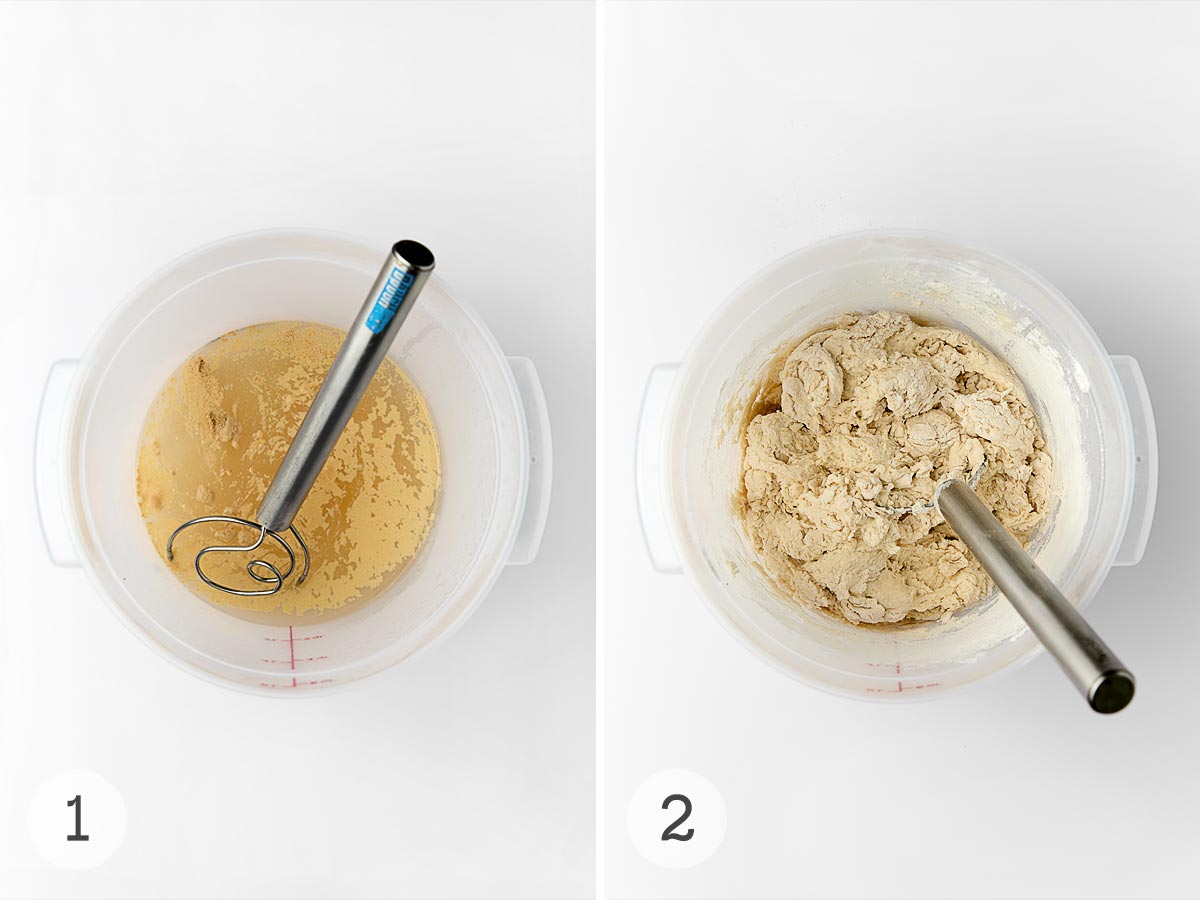
- Mix the warm water, yeast, and salt together in the bowl of a stand mixer or a large container, such as a lidded dough bucket.
- Add the flour and mix just until the flour is completely incorporated.
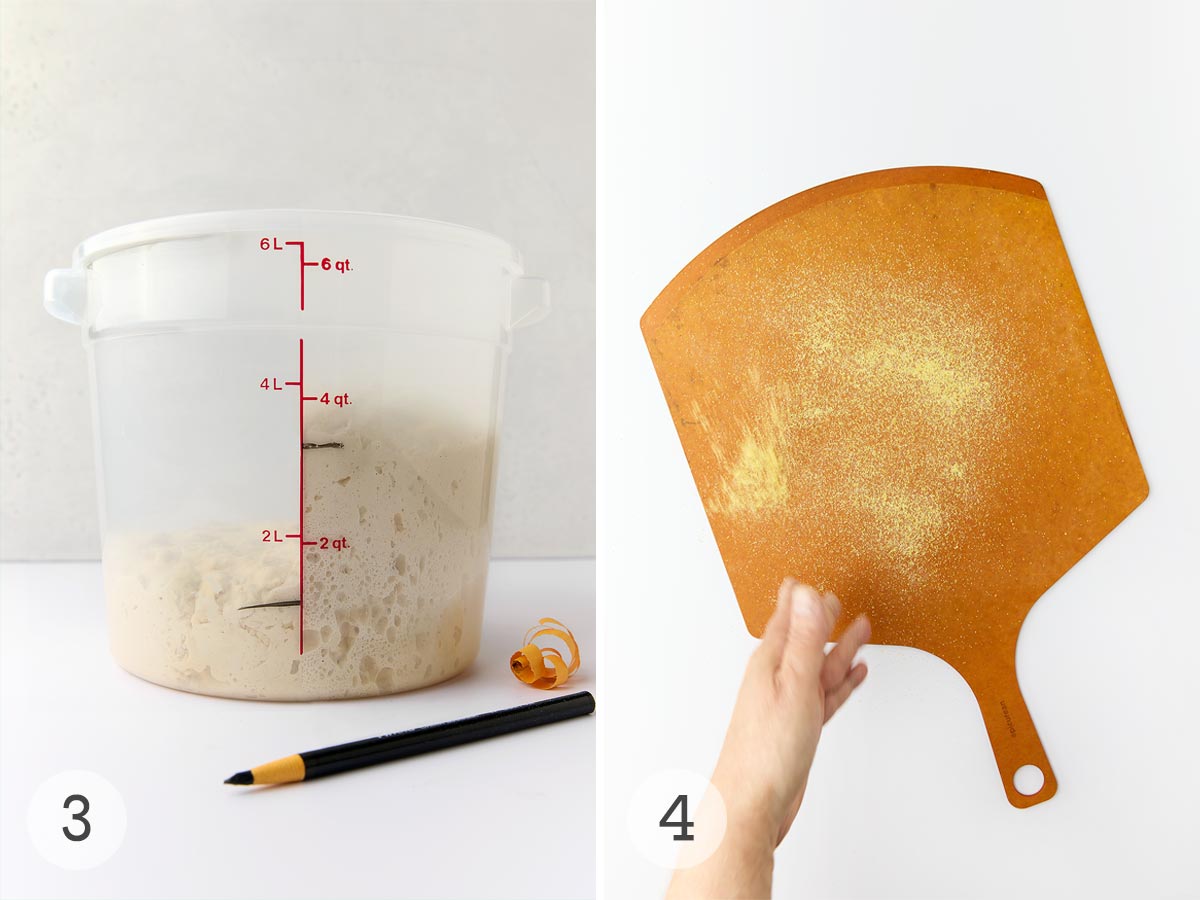
- Loosely cover the mixing bowl or container and let the dough rest at room temperature for 2 hours, then store the dough in the fridge until you’re ready to bake.
- Dust a pizza peel or inverted baking sheet with cornmeal or line it with parchment.
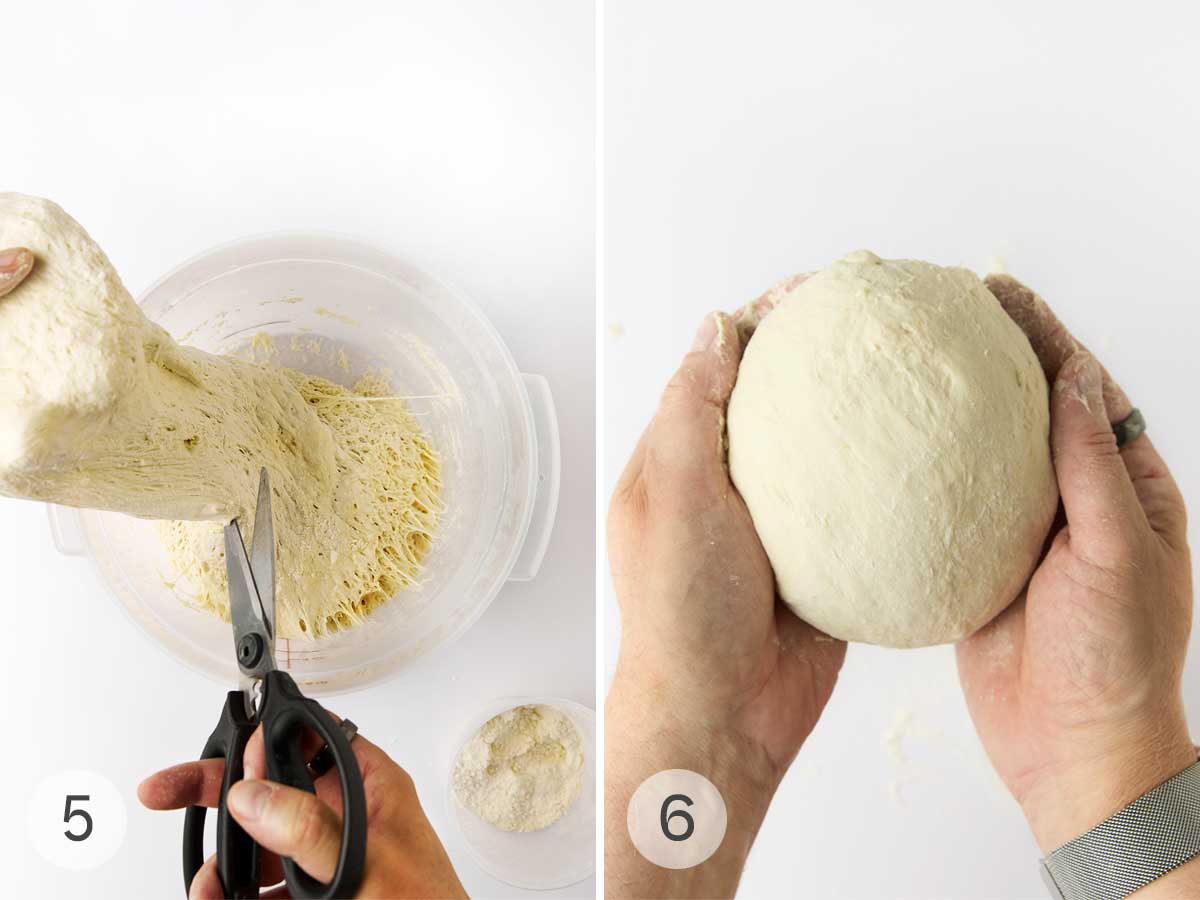
- Cut off a 1-pound piece of dough and dust lightly with flour.
- Gently stretch the surface of the dough, gathering the ends underneath, to create a smooth ball.
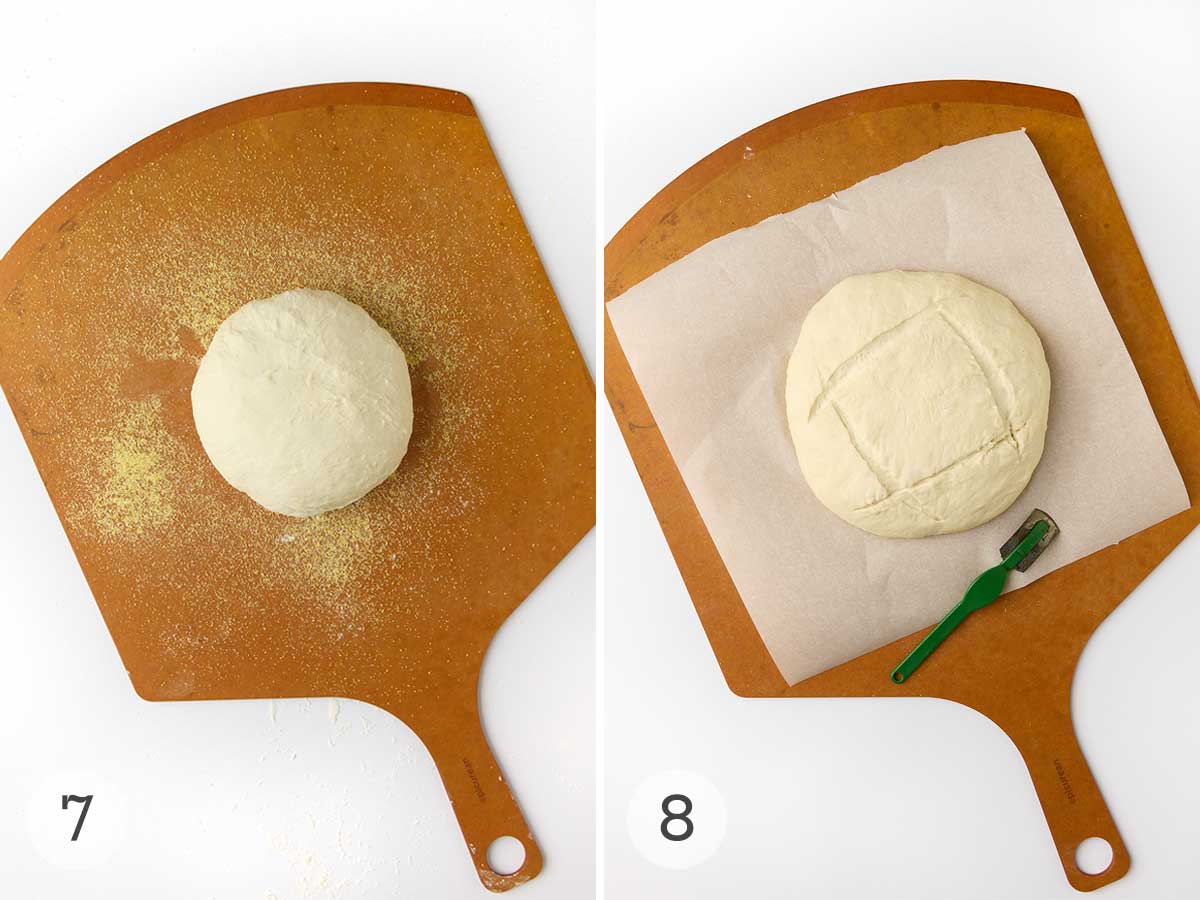
- Place it on the pizza peel or baking sheet and let it rest for 40 minutes.
- Preheat a baking stone or baking sheet in a 450°F oven while the dough’s resting. Place an empty broiler tray on a rack below. Dust the dough with flour and cut a gash across the top of the loaf.
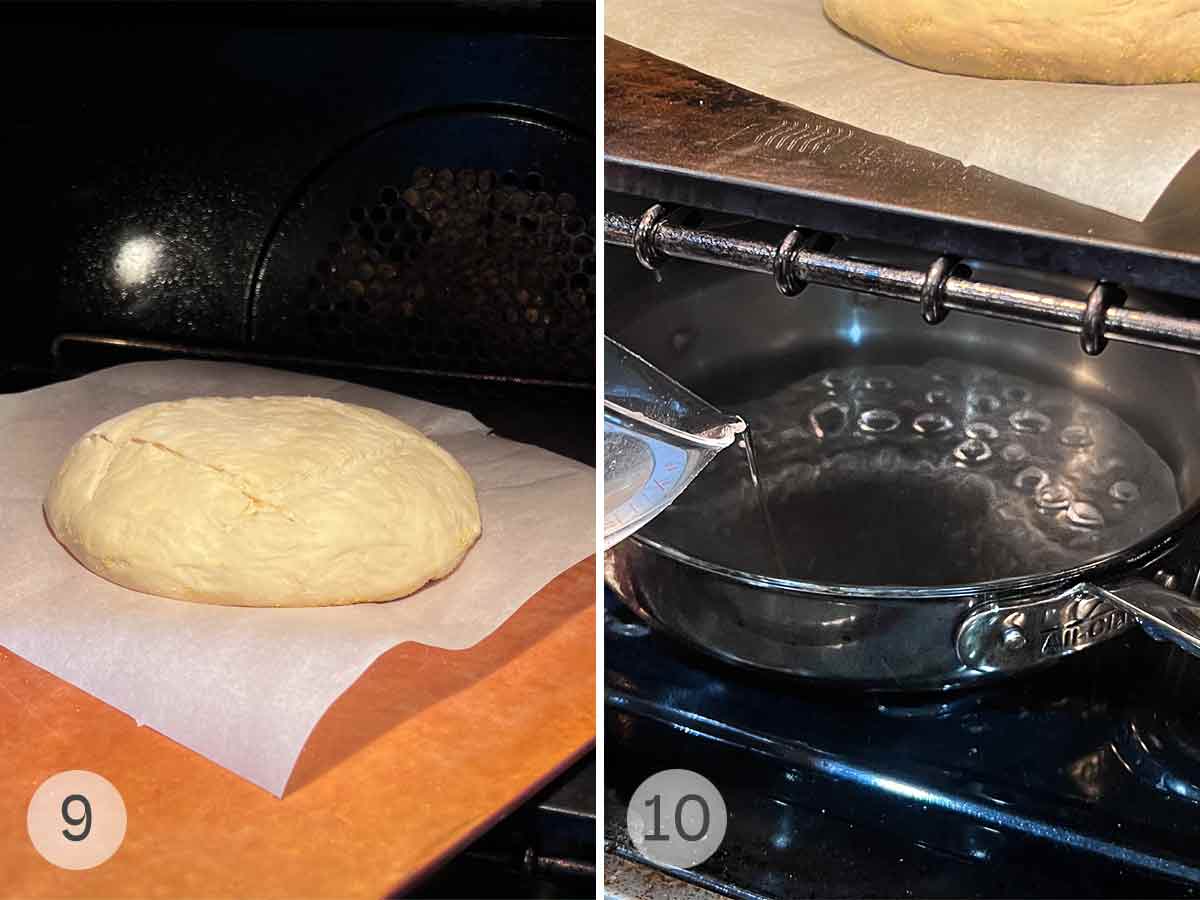
- Transfer the loaf to the baking stone in the oven.
- Pour 1 cup of water into the broiler tray to create steam. Bake the bread until the crust is firm and well browned. Cool completely before slicing.
Your No Knead Bread Questions, Answered
Okay. If you want to get technical, this bread does take a little more than 5 minutes to make, but that’s only if you include the resting and baking time. But in terms of actual effort? Seriously, it’s just 5 minutes. We’ve relied on this recipe hundreds of times, and we can assure you that 5 minutes hands-on time is all you’ll ever invest at any given stage in the recipe. That’s nothing for a loaf of rustic artisan bread that’s homemade. Nothing short of a miracle, that is.
You absolutely can use a Dutch oven here. I do it often. Use the temperature stated in the recipe. You’ll want to preheat your Dutch oven (and its tight-fitting lid) for at least 30 minutes. To help you lower the loaf in the pan without burning yourself, make a parchment-paper sling.
There are several reasons. The biggest issue is a poorly calibrated oven. Even twenty-five degrees can make a difference. Always use an oven thermometer to be absolutely sure.
The second issue is not enough steam in the oven. Now, I know what you’re thinking: How can moist steam make for a dry crisp crust? It all has to do with the starches present in the flour. When the bread bakes, its skin heat up enough so that the starch molecules pop open and become jelly-like. They then continue to bake and firm up to a crusty loaf. The moisture from steam is what kicks this process into action.
In step 14, the hot water splashed into a shallow pan is what creates that steam. If you use a Dutch oven, there’s enough steam from the wet dough to do the job. Although, I often toss a few ice cubes in the pot for good measure.
Storage and Freezing
This bread is best enjoyed the day it is made, but it can be wrapped in a clean dish towel or foil or stored in a plastic or paper bag for up to 2 days. The bread can also be frozen, sliced or unsliced, for up to 2 months.
If you won’t be able to bake all of your dough within 14 days, the unbaked dough can also be frozen in 1-pound pieces, wrapped tightly in plastic. Thaw and let rise in the fridge before baking.
Pro Tips
- For best results, measure your ingredients by weight.
- Warm water is ideal for proofing yeast, but take care to not use very hot water (over 115°F) as it can kill the yeast.
- Place a sticky note or a piece of tape with the date that you made your dough to help ensure that it gets baked within 14 days.
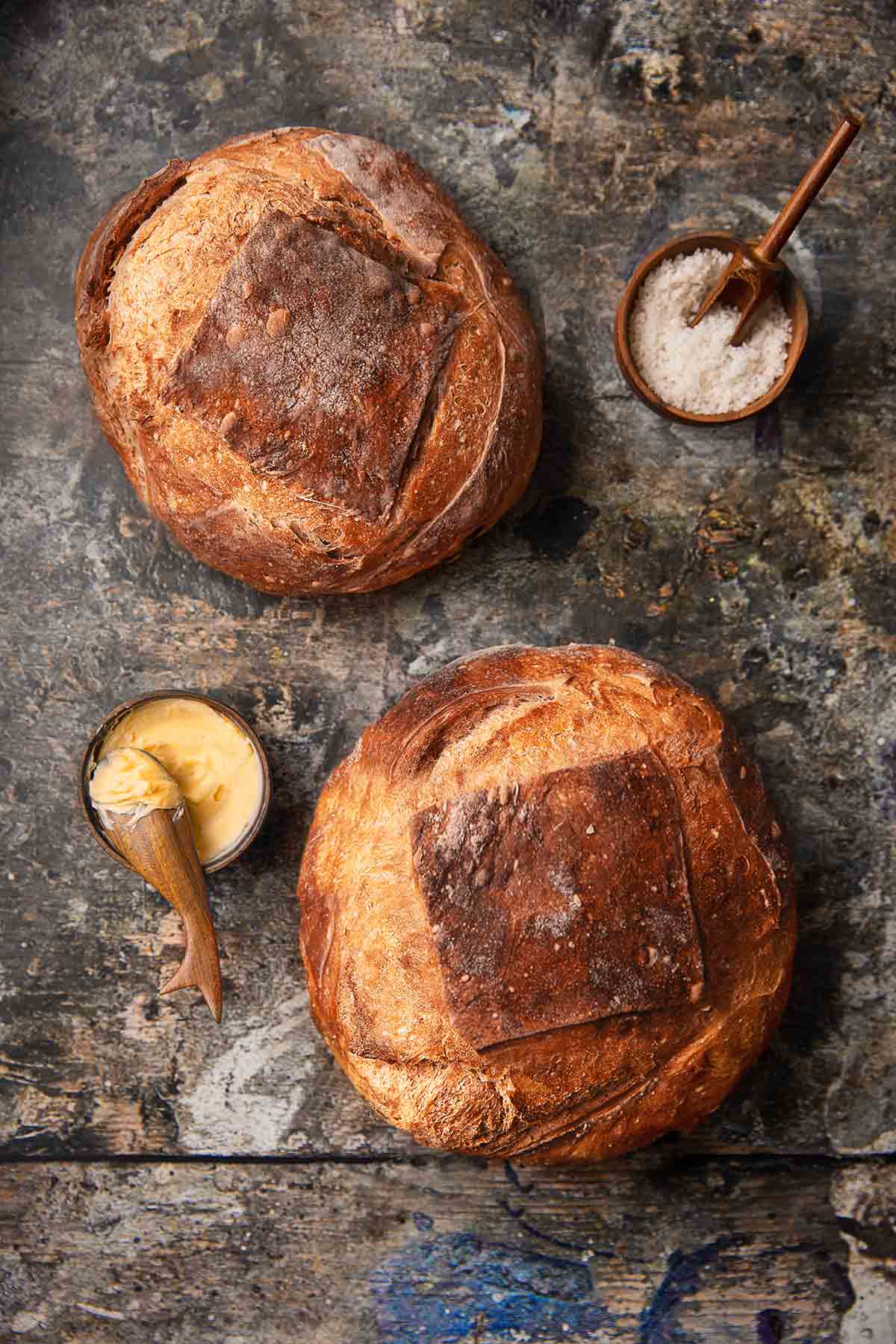
Write a Review
If you make this recipe, or any dish on LC, consider leaving a review, a star rating, and your best photo in the comments below. I love hearing from you.–David
I am a complete novice and made this bread for my very first attempt ever. The instructions were wonderfully detailed and my loaves turned out beautiful and delicious. Thank you so much!
Jennifer B.
Video: How to Shape No Knead Artisan Bread
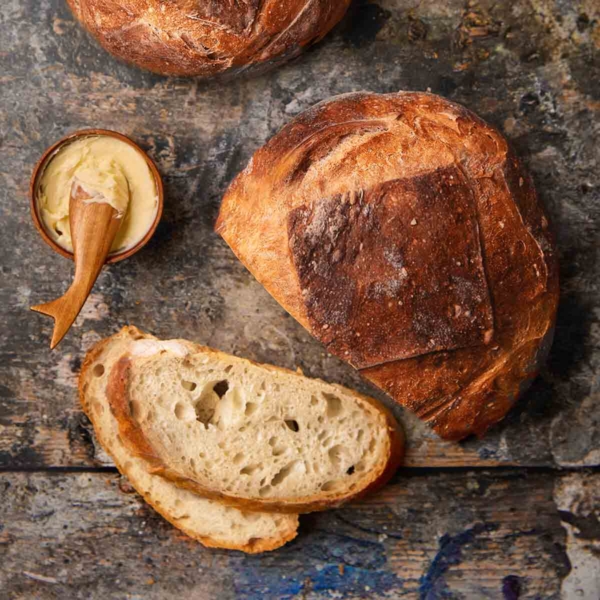
No-Knead Artisan Bread
Ingredients
- 3 cups lukewarm water, (100°F or 38°C) plus more for the broiler tray
- 1 tablespoon granulated yeast, (active dry, instant, quick rise, or bread machine is fine)
- 1 to 1 1/2 tablespoons kosher salt, to taste
- 6 1/2 cups unbleached all-purpose flour, measured by the scoop-and-sweep method
- cornmeal, for dusting (optional)
Instructions
Make the dough
- Mix the 3 cups lukewarm water, 1 tablespoon granulated yeast, and 1 to 1 1/2 tablespoons kosher salt in a large bowl or a 6-quart container with a lid.
- Add the 6 1/2 cups unbleached all-purpose flour to the yeast mixture all at once, then using a spoon or Danish dough whisk mix until the flour is completely incorporated and you have a gloppy dough.
☞ TESTER TIP: Don’t knead the dough! You want the dough to be uniformly wet and loose with no dry patches of flour.
- Loosely cover the bowl and let the dough rise at room temperature until doubled in size, about 2 hours.
Stash the dough in the fridge
- Once the dough has risen, stash the bowl or container in the fridge.
☞ TESTER TIP: If your container isn’t vented, you want to ensure the gases can escape by leaving the cover open a crack for the first couple of days in the fridge.
- You can use the dough anytime after the initial 2-hour rise, although it'll be quite wet and sticky. I prefer to let the dough rest in the fridge overnight (8 to 12 hours).
☞ TESTER TIP:
No matter when you use it, don't punch down this dough! And be certain to use the dough at some point within 14 days.
Shape the dough into a loaf
- When you're ready to bake a loaf, dust a pizza peel or an upside-down baking sheet with cornmeal or line it with parchment paper.
- Grab a hunk of the dough and use kitchen shears to cut off about a 1-pound piece. If needed, add just enough flour so the dough doesn't stick to your hands.
- Gently stretch the surface of the dough, tucking the ends underneath the ball and rotating it a quarter turn as you go. Most of the dusting flour will fall off, and that's okay. The bottom of the ball of dough will look a bit ragged; it will flatten out and adhere during resting and baking. The top and sides of your loaf should be smooth and taunt, and the shaping process should take no more than 20 to 30 seconds—don't work the dough any longer, or your loaves may be dense.
- Place the dough ball seam side down on the prepared pizza peel or baking sheet. Let it rest for about 40 minutes. It doesn’t need to be covered. You may not see much rise but don't fret. It'll rise plenty during baking.
Bake that gorgeous-looking loaf
- While the dough rests, slide a baking stone or an upside-down baking sheet onto the middle rack and crank up the oven to 450°F (230°C) for at least 30 minutes. Place an empty metal broiler tray or an ovenproof skillet on a lower rack. (Don't use a glass pan as it could shatter.)
- Dust the loaf generously with flour and, using a serrated bread knife, slash a 1/2-inch-deep cross, a couple of gashes, or a tic-tac-toe pattern in the top.
- Place the far edge of the peel on the baking stone a few inches beyond where you want the bread to land. Give the peel a couple of quick back-and-forth jiggles, and then yank it out from under the loaf.
- Quickly but carefully pour 1 cup of hot water into the hot broiler tray or skillet and immediately shut the oven door to trap the steam.
- Bake the bread until the crust is richly browned and firm to the touch, 20 to 35 minutes.
☞ TESTER TIP:
If you're using a baking sheet rather than a baking stone, you may need a little extra time—up to 50 minutes total—for the bread to be done. - Remove the bread from the oven and let the loaf cool completely on a wire rack for the best flavor, texture, and easy slicing.
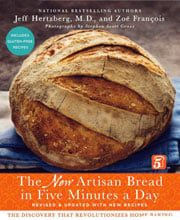
Nutrition
Nutrition information is automatically calculated, so should only be used as an approximation.
Recipe Testers’ Reviews
Wow! What a gorgeous, beautifully colored, irresistible loaf of artisan bread! I wish I’d made more loaves at the same time. The loaf had a chewy crust and a beautiful interior.
The ingredients for the dough were fast and simple to assemble. I used a wooden spoon and didn’t need a mixer. I placed the dough in a large, ungreased Tupperware with a lid and rested it on the counter for 2 hours. Then I placed the container in the refrigerator, loosely covered, and waited 2 days to use the soft, spongy, yeasty-smelling dough.
Forming the boule and transferring it to my hot pizza stone was simple enough. I made a tic-tac-toe pattern on the top of the loaf, and there was definitely a significant amount of flour on the loaf, but it didn’t burn. My loaf baked for 25 to 30 minutes.
I nearly always have some of this no-knead 5-minute artisan bread dough in the fridge. This bread is a simple 4-ingredient dough.
I used a wooden spoon in a large mixing bowl and finished with my wet hands. The dough was very lumpy and sticky. After the 2-hour rise, the dough was full of holes, which are very noticeable throughout when using a glass bowl.
After refrigerating the dough overnight, it was very easy to work with. So easy, in fact, I really didn’t need to flour the surface before cutting a loaf-size amount from the dough. I made a couple of boules, and while they had a nice crumb, the crust was spectacular!
This dough is perfect to have on hand for any occasion. If, like me, you love a crisp, crunchy bread, this recipe is for you. If you leave the dough in the fridge for at least 48 hours, the crumb has many more holes. When you use it the next day, the crumb is much tighter. I prefer mine with holes to capture all of the goodies that I apply.
This no knead 5-minute artisan bread recipe has to be the easiest and fastest way to make bread. It’s also now my favorite way to make bread dough—and a decent loaf or boule of bread with little effort. It’s truly one of the best recipes for artisan breads I’ve tried.
I made a free-form boule and a loaf in a traditional loaf pan. I found that after baking the loaves for 30 minutes, I had a tanned boule, much like a round sourdough loaf. I found this loaf had a moist and dense crumb and a crunchy crust. As for the loaf pan, I found that batch didn’t rise as much, but this may be due to my handling of the dough. It was still delicious. This is certainly a way to wow on a weeknight, as the bread does its own thing while you prep dinner. It’s an easy rustic bread recipe that’s adapatble and impressive.
I used a 10-quart storage container with a lid. While the dough was rising, I left 1 corner open, and then when I refrigerated it, I closed that corner. It really is a good idea to open it the first few days to allow the extra gases out. I find it’s a good workout mixing the dough with a wooden spoon (about 6 or 7 minutes of mixing), but I’ve used a stand mixer in the past with other bread doughs for speed (about 3 or 4 minutes). Both work equally well. The resulting dough looks like wet pizza dough, sort of jelly- or pudding-like. When the work is done, all that remains is to use it within 14 days. I so far have not had this dough last a week.
The only suggestion I would make is that you should check your yeast to make sure it’s still viable before mixing your dough. I forgot to do that, and my first batch failed to rise. I replaced my yeast with fresh, and the second batch performed as it should.
This no knead artisan bread is absolutely delicious! I love the warm, earthy flavors, the spongy, chewy texture, and the crisp crust. Great recipe.
I just used the last of the dough that was in the refrigerator. However, I don’t have a pizza peel, so I used a small bread board with a handle. When I tried to put the dough on the baking stone as instructed, it fell and lost its shape, and I had to pick it up and re-shape it. I took the bread out of the oven when it was 210°F, and the top was richly browned. It took only about 20 minutes to bake the bread.
This recipe was well worth the time.
I’m going to start off by saying that this easy no-knead artisan bread dough is gorgeous, comes together without a hitch, and turns out a rustic loaf. I followed the directions precisely and used exactly 6 cups flour. It’s a lovely, sticky dough that’s a bit difficult to work with unless you’re used to working with loose doughs. The resulting boule was golden brown, with a lovely crust, fantastic chew, and wonderful flavor.
After allowing the dough to rest in the fridge for 2 days, I embarked on making the boule. I followed the directions precisely, and even without a pizza peel, I was able to put the formed boule onto the preheated baking stone without changing the shape too much.
Don’t be scared to use a lot of flour to help you shape the dough—it won’t get incorporated at all, and it looks rather gorgeous against the burnished crust. I baked the bread for exactly 30 minutes and then placed it on a rack to cool.
This recipe is so easy and would be a good one for first-time bread bakers. You don’t really need any fancy equipment. Just a bowl, a spoon, and a baking sheet.
I used all-purpose unbleached white flour and Red Star instant yeast. It took all of 10 minutes to mix up the dough. After a 2-hour rest at room temperature, the dough was refrigerated for 3 days before baking.
I made 2 loaves. Shaping was easy and I was careful to not knead or add much flour. After a 40-minute rest on the baking sheet, it went into the oven. Pouring the hot water into the boiler tray was an exciting flash facial! I baked for 35 minutes until an instant-read thermometer read 190°F. Let cool for a few hours–and yes, it did crackle and sing!
We really enjoyed this bread, especially toasted. The crust was super crispy. I was expecting the interior to have some bigger air pockets but the texture was very uniform. The taste wasn’t super complex but still delicious.
I am familiar with the book by Jeff Hertzberg and Zoë François, The New Artisan Bread In Five Minutes a Day, and while I had never made this recipe, when I saw this test recipe, I knew it was time to try their approach.
What I particularly liked is the simplicity of the bread making. The results are very good. I can see the appeal of this method to breadmaking as anyone can have fresh bread in very little time because you have a loaf ready to go just sitting in your fridge. I made my loaf 8 days after making the dough, and the flavor was excellent! This truly is one of the best no knead artisan bread recipes I’ve tried.
Homemade bread is such a luxury but it can be intimidating to try to make it. There’s nothing intimidating about this recipe. It’s as easy as it sounds. The hands-on time is truly only 5 minutes. (I have to admit, I was skeptical when I saw “5 minutes’ as part of the title, but it’s true!!!
There are only 5 ingredients in this recipe and one is optional (which I didn’t use). I used my mixer to combine the ingredients, which took about 1 minute. I couldn’t believe how fast this all came together. The hands-on time is very brief but there’s a waiting period to let your dough rest and rise. I made mine one day and put it in the refrigerator after it sat at room temperature for 2 hours.
I baked the first loaf of bread the next day. It was excellent. It’s a heavier bread and it’s delicious. I served it to company and the whole loaf was completely gone! I baked mine on a baking sheet lined with parchment paper for 25 minutes. This recipe requires little effort and delivers big! It’s one of the easiest recipes for artisan breads to impress guests.
The bread was simple and delicious! I felt very fancy baking my own bread and it was easy enough that I will do this again.
The notes throughout this recipe make bread baking approachable for any level of baker. The instructions were conversational yet specific, and were consistent with the results I saw. For example, step 10 reads like the author is there coaching you, gently encouraging you to shape the sticky dough into an attractive mound while note overworking the dough.
I also liked that the recipe made a large batch of dough that could be stored in the fridge and baked off one loaf at a time as needed.
I hand-mixed the dough with a rubber spatula with no issues. Step 5 indicated that after a couple days, venting was not necessary, but my dough continued to expand in an airtight container after one week in the fridge. A larger bowl is probably better if possible.
Be careful when adding boiling water to the hot tray because it steams up immediately.
I baked my loaves on a dark cookie sheet with parchment. After baking three loaves, I determined that the best method for my oven was to bake the bread on a lower rack for about 25 minutes, then do the last 5 minutes on an upper rack (requiring me to swap the bread pan and water pan) to brown the top of the loaf. Otherwise, the underside of the loaf is too pale and not crusty/chewy enough. I baked the third, larger loaf for an extra 5 minutes (35 total).
The first loaf was baked on day 1 (after about 6 hours in the fridge), the second on day 4, and the third on day 9. The second and third seemed slightly more flavorful than the first to me, and were definitely more fragrant (think bready/yeasty/sour notes). The second and third seemed to be less dense and have bigger air pockets throughout, as well as a chewier crust.
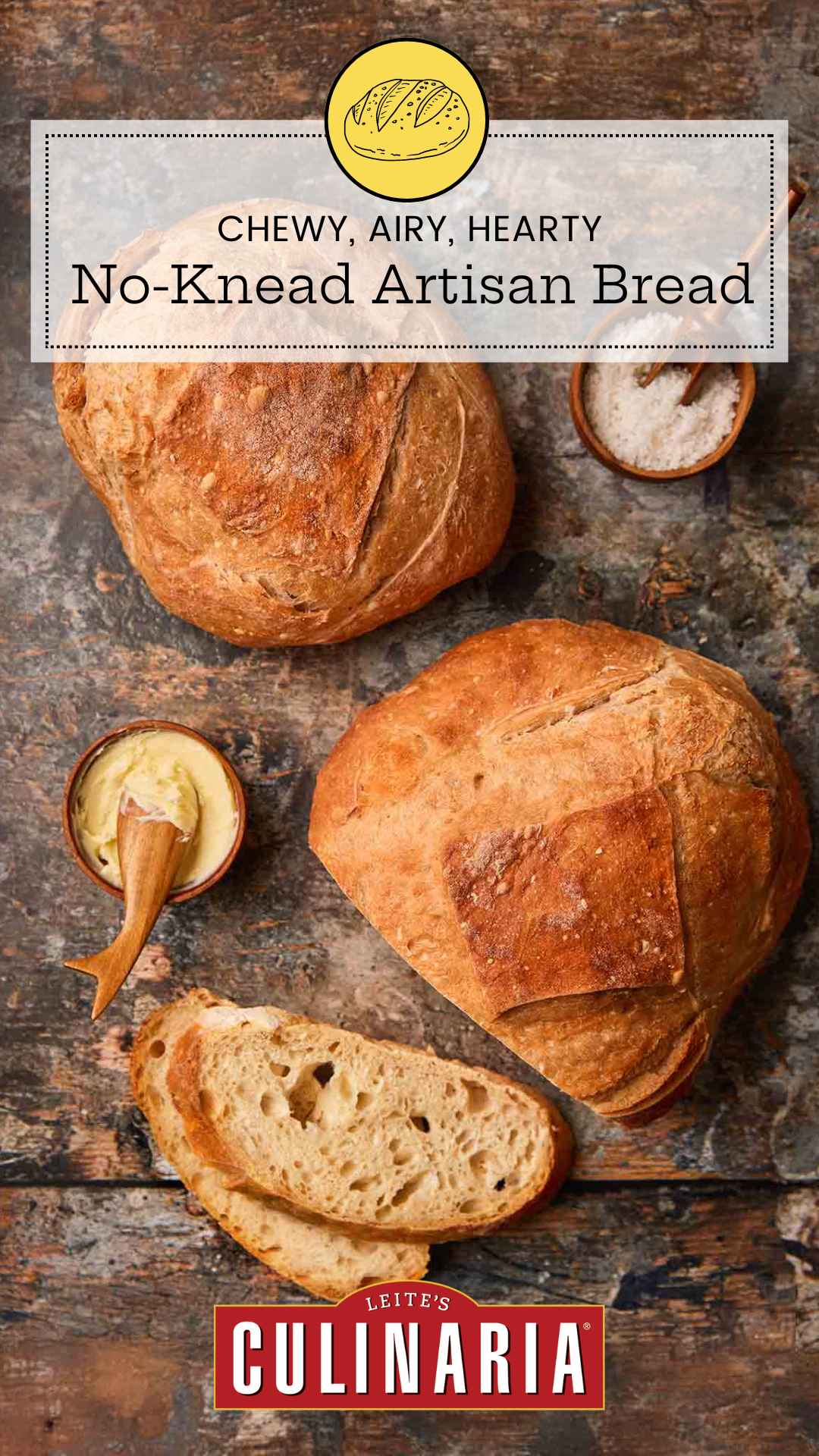
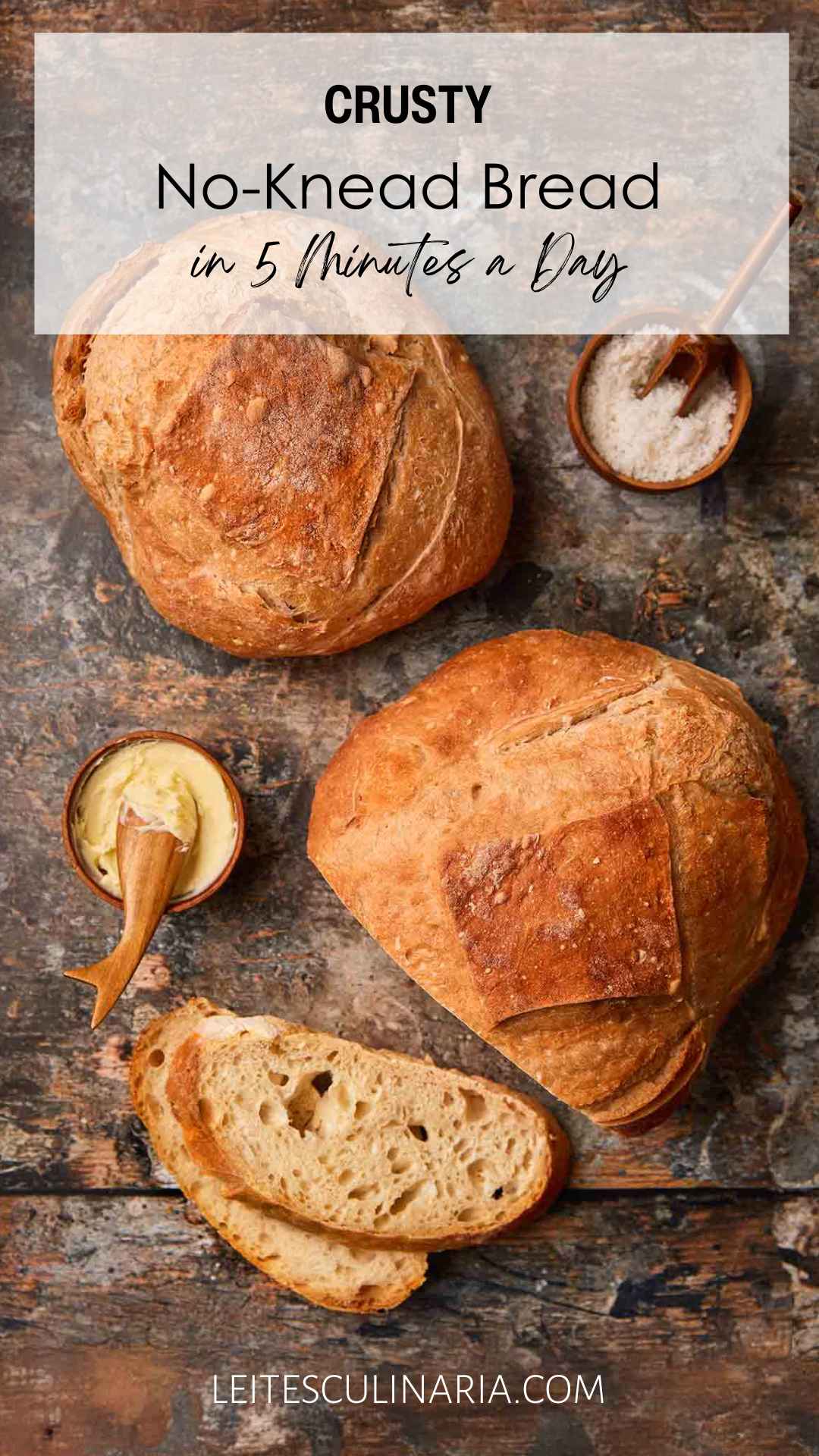
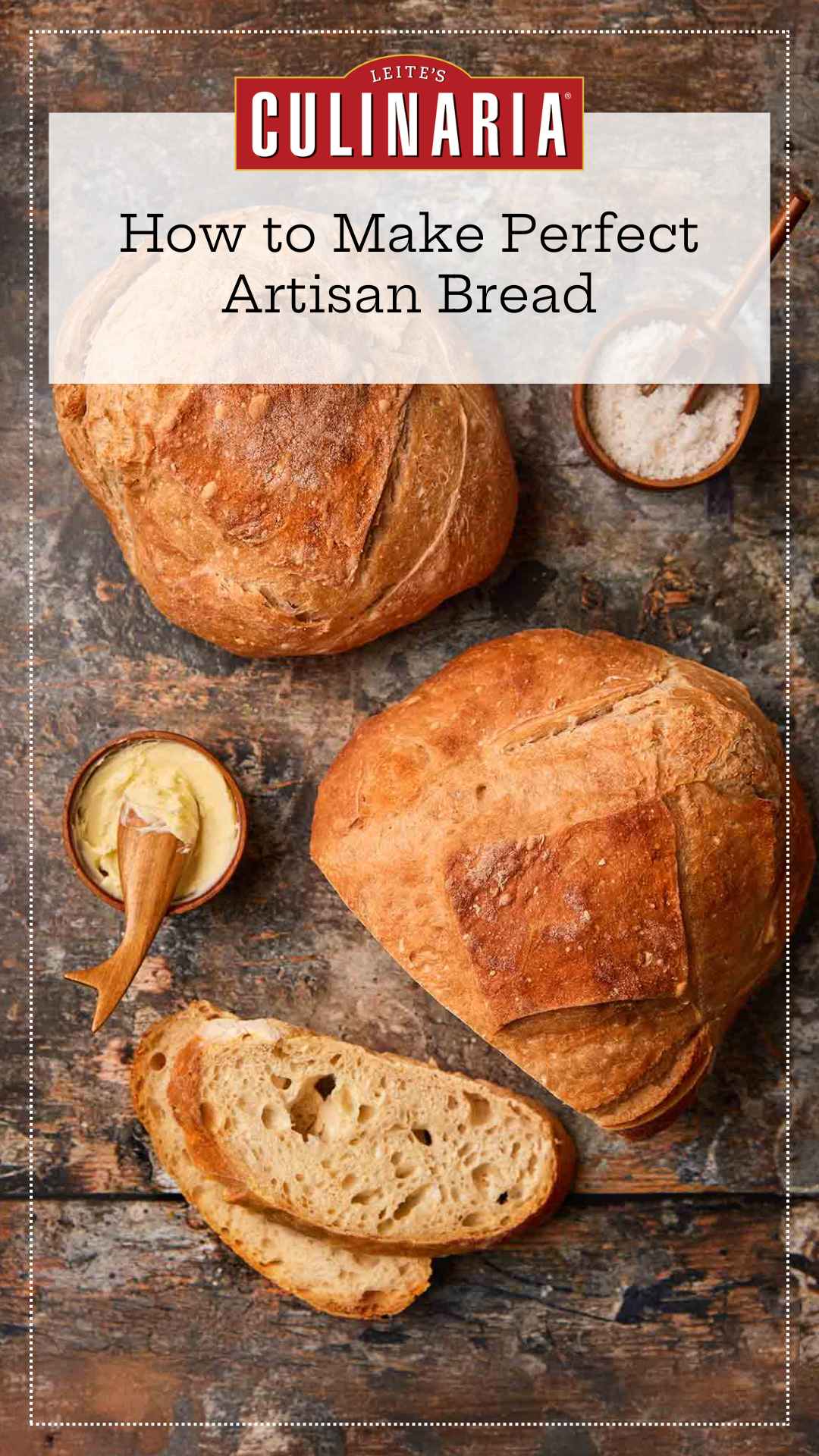
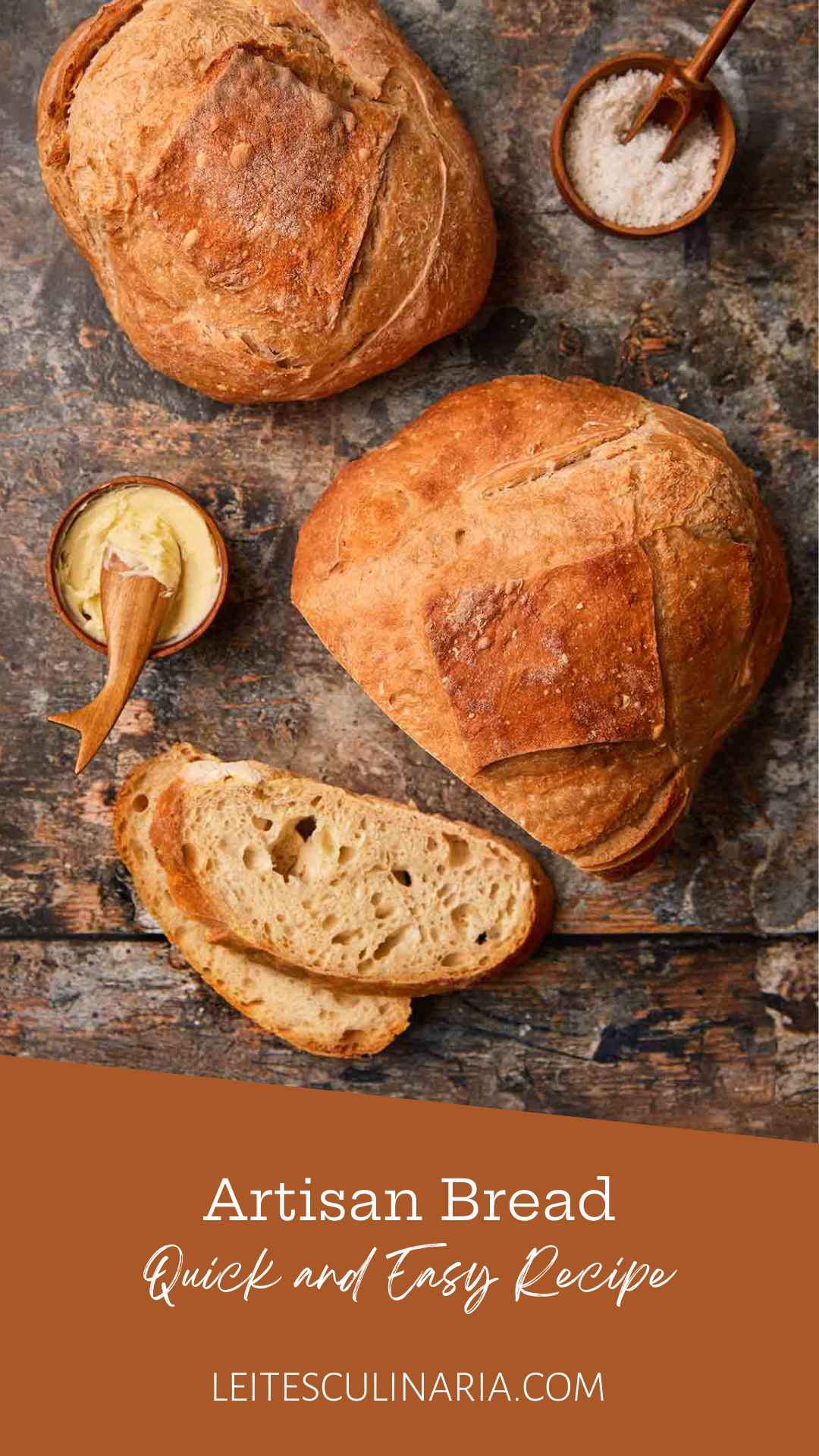
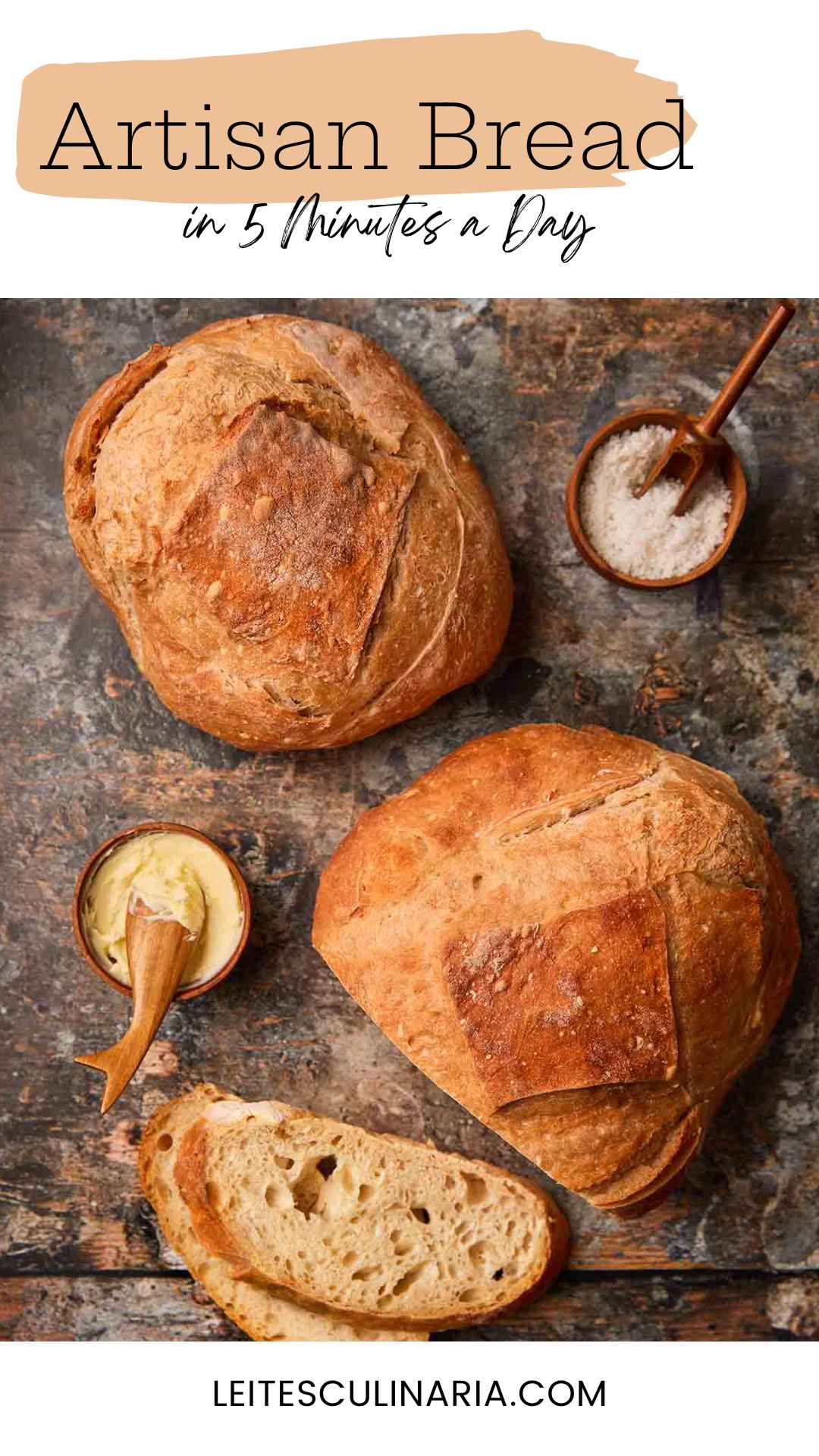
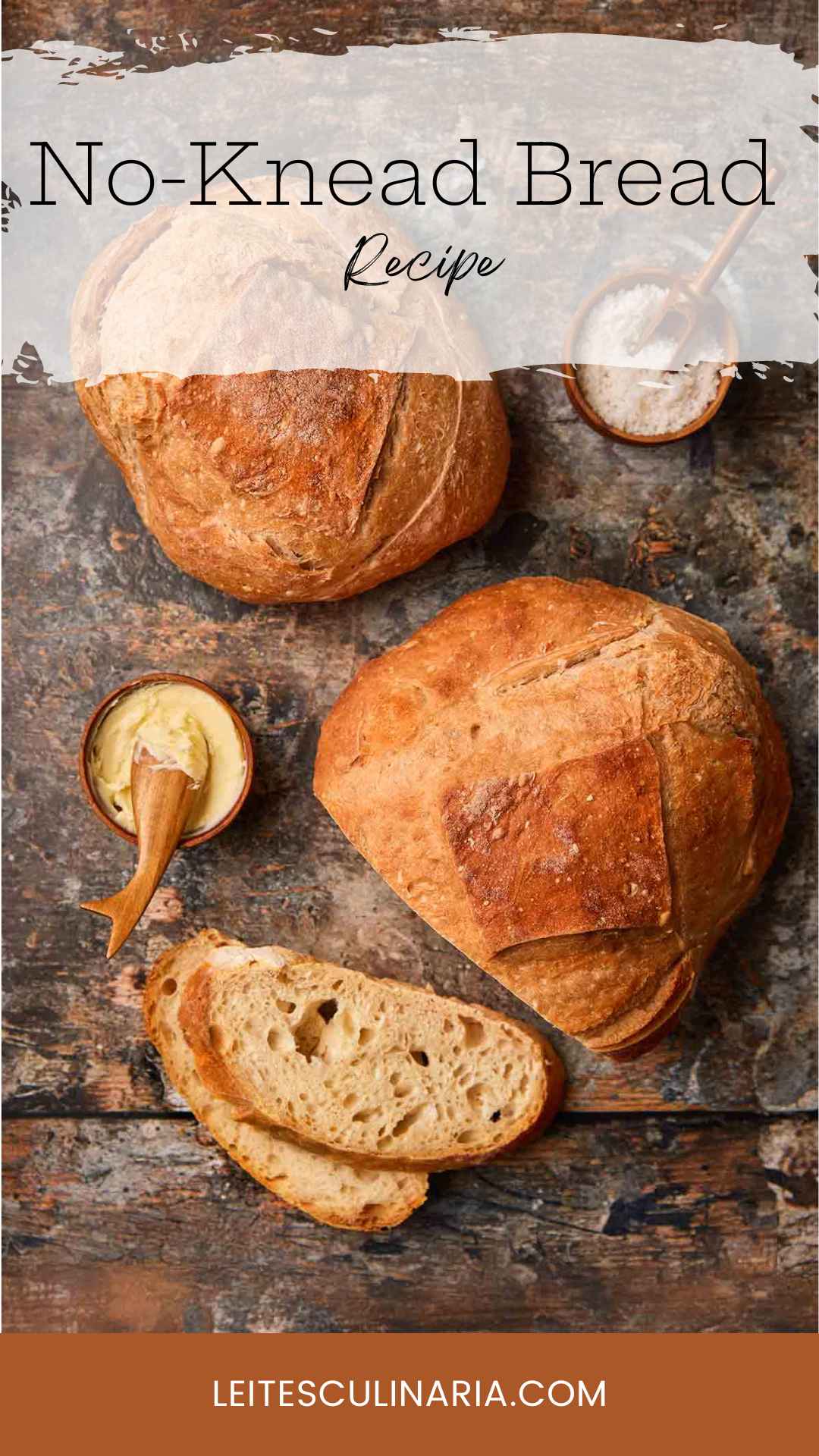
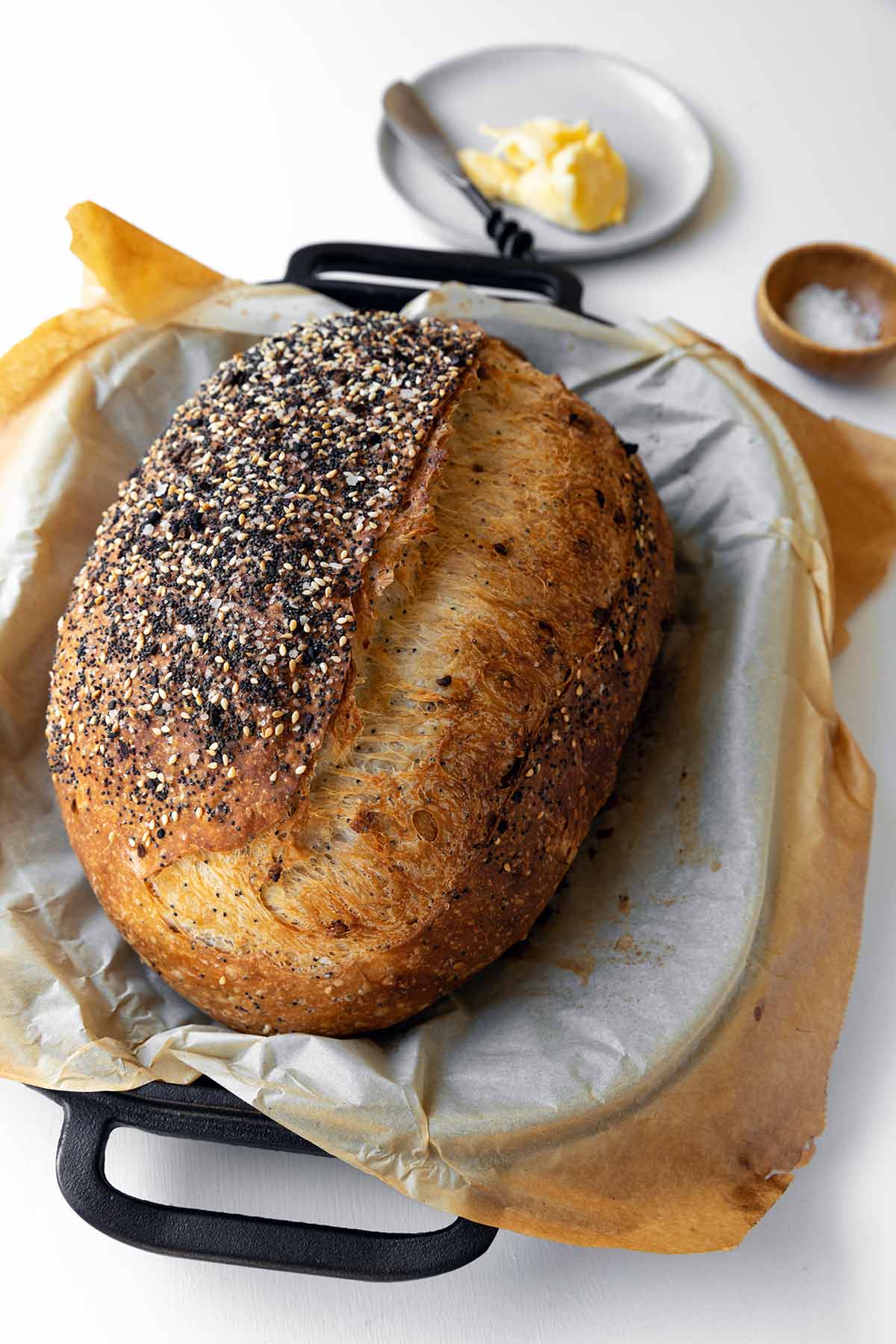
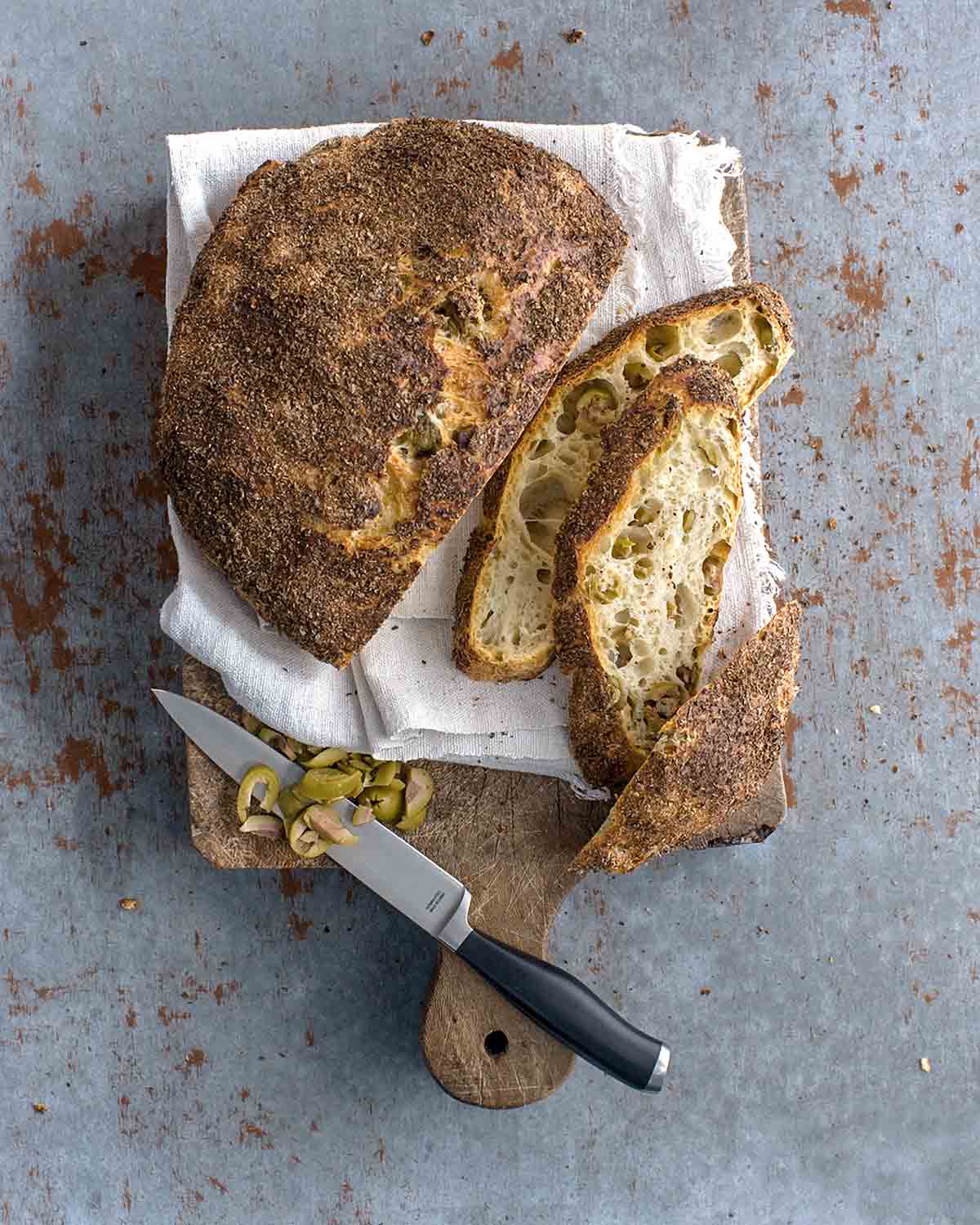














Has anyone ever tried making raisin bread using this dough recipe? i’m a complete novice bread maker but would be as simple as adding cinnamon and raisins to the dough when making it and baking as normal?
Dave, that’s about the sum of it. This post by Zöe and Jeff might help.
Awesome – I’ll give it a shot. Love how versatile this bread recipe is!
Dave, it is, indeed, incredibly versatile! I wanted to share some advice with you on adding raisins (or nuts or olives) to bread dough from our resident professional bread baker. I’ve tweaked it slightly as it was in response to a reader query about adding olives to ciabatta, although it applies to raisins and any bread dough as well. There are two methods she recommends. Here’s what she has to say: “The first method gives a stronger raisin-y taste all through the bread by incorporating the raisins at the beginning of the kneading. This is what most beginners do with any addition such as olives, nuts, cheese. Yes, this means a more uniform distribution and the taste of the addition throughout the loaf, but I almost never do it this way because it requires adjustments to hydration (more for dry ingredients, less for wet ones) and, more important, it can interfere with gluten development. The second method, my preferred technique, is to add the raisins (or olives, nuts, cheese) after the dough has fully developed—that is to say, after it has been kneaded completely. Just knead the raisins in by hand before the first rise. With this method, you should not need to adjust the water. A problem that arises with additions (using either method above) is that they pop through the dough and whatever bits are exposed to the heat get dried out and hard. Not pleasant when it happens. With a regular country loaf, there’s two ways to minimize that. You can simply push the pieces that peek out after shaping the dough back into the dough before setting it to proof. That helps quite a bit. A fussier, but totally effective, approach is to cut off a piece of plain dough before the addition. I eyeball it at about 1/4 of the dough. Add the raisins to the larger pieces and shape the loaf. Then roll out the reserved piece to a thin sheet and drape it around the shaped dough, sealing on the bottom. This keeps all the bits inside, entirely preventing pop-throughs.” Kindly let us know how it goes!
I absolutely adore this bread and have made a dozen or more loaves with great success. I have only tried the whole wheat recipe once (with hard red winter wheat) and while it was a bit denser than the AP version, it was still quite good.
My question is about the addition of other ingredients. Do you mean above that you mix the dough as you would normally and then add in cheese/olives/nuts/herbs and then do the 40-90m rise? How much volume of additions would be acceptable to add? And would you grate or cube cheese? Would garlic or onion be better added as powdered or fresh chopped/minced? I’m just looking for some ideas to kick off my experimentation!
Thank you to Jeff and Zoe for this unbelievable bread!!
Lovely to hear that you adore this bread, Maddie! Thanks so much for taking the time to let us know. As for the addition of other ingredients, yes, in the method described in my comment above, I say to add those sorts of ingredients as you’re kneading the dough before the first rise. I think the amount is going to be dependent on personal preference and will depend on the specific ingredient but figure about a handful. As for the cheese, it depends if you want a more wispy hint of cheese that almost melts into the dough (grate) or blobs of cheese throughout (cube). If adding garlic, I would add roasted garlic that you’ve mashed into a paste or minced garlic that you’ve sauteed but beware garlic can be so pungent!
This is a super long comment, but I feel excited and I just want to share my experience. I have to be honest, I’m kind of a visual-learner, so twice I tried to bake artisan bread, using 2 different recipes but based on the same source, twice I failed. My main issue (it’s not you, it’s me – this time I mean it) is that because I use metric measurements and I don’t have measuring cups, only a scale so I was doomed from the start. Also, because I don’t have a model before me, I couldn’t make out the liquid and flour ratio, how the right consistency looks like, how wet is not-wet-enough, how wet is just right? I know I got the “too-wet” right on the nose because both my attempts came out looking like flatbreads, waited 2-times overnight proofing for 3 focaccia-looking things and 1 sad loaf (if you put the dough in a loaf pan, it will come out quite decent, mine needed a bit more time in the oven than the round ones though – cannot bring myself to call them boule, they were just disks! *crying invisible tears*). But in the end it’s all great, please don’t think I’m mad, I typed the whole thing above with a smile on my face. Because 1st attempt I put chopped fresh rosemary and roasted garlic in the dough, though gravely disappointed with the shape, the smell swept me off my feet and I just had to slather on an unhealthy amount of butter on the first slide. After 1 bite I was knocked out cold, it was so divine that I just couldn’t stop eating! The crust was crispy and the inside was soft and chewy (I used wholewheat strong flour). 2nd attempt, I used this recipe, still put rosemary and roasted garlic in, this time with fresh thyme as well. I thought this flavour-combo would suit savory food only, but then I told myself “to hell with it” and tried it with marmalade and Nutella. My sweet tooth was satisfied, thoroughly satisfied! I think I’m gonna go broke for just buying flour and yeast alone, I’m so addicted to baking bread now!
TL;RD: Thank you so much for this recipe, thank you for all the work you’ve put in. You’re all wonderful beautiful people and I love you!
Jo LD, while I’m thrilled you’re happy, I’m dismayed that you didn’t get the results we promised: a nice, round boule! What can we do to help you get there? Would metric measurements help?
Thank you for replying and oh yes, metric measurements would be a lifesaver. There are so many conversion websites on cups-to-metric but they are so inconsistent and vague (I can’t measure 275.98753 grams and 445.5879743 milliliters!). And if I could have a description of what the dough’s consistency is like after mixing, I would be so grateful (and if I can have a picture, then you’re a saint, because you’re a godsend already :D). May I ask for one more thing, my personal taste leans more on breads with chewy inside and a great crunchy crust, preferably wholegrain/wholewheat, so could I trouble you for more bread recipes that fit the description? (English is not my mother tongue so I hope you get my gibberish.) Thank you for your help and best wishes to you and your loved ones!
Jo, I just input the metric equivalents for the recipe so that you can make it. The dough is going to be pretty standard after mixing as far as American-style bread doughs go and not nearly so wet as most Italian doughs. (I hope that helps. I’m not certain what types of bread dough you typically make.) As for more whole grain bread, we have a truly lovely rye bread publishing on the site in the next couple weeks so kindly keep that in mind. We are constantly testing whole grain bread recipes in our kitchens but most of the time they don’t make it to the site because they end up overly dense. But we continue to search and will let you know when we find one that we feel is stellar enough to share!
Update on the artisan bread journey: I finally got around the liquid measuring (3 cups = 700ml roughly) and because I used instant yeast, I didn’t mix the yeast with water or anything. I just mixed the dry ingredients together with my stand mixer and gradually added water like with most bread (I don’t know if it’s going to change the bread’s quality). Was a tad confused with how wet is too wet (again) but thanks to that video on this recipe that I saw somewhere in this comment section, I managed to get an idea on how the dough’s consistency would be (visual learner struggles). Covered with a tea towel for both proofs, and when I got it out of the fridge to bake it, I almost choked up because I could finally hold the damn dough! I don’t have a baking stone so I just put a baking sheet in the oven while it was heating up (made pizza that way, perfect every time) and after that 40 minutes rest I put the dough (shaped into 2 boules) on parchment paper and put the whole thing on that heated baking sheet (and burned on myself on the wrist, but I got a bunch of oven-burn scars on my hands already, I like to call them my “battle scars”). After 26 minutes, I checked on the breads and oh my goodness, they were beautiful. I had to turned them around for an even colorization because my oven gets hotter at the back, and when they were not as dark as I expected, but I didn’t want to push my luck and dry them out just to get a darker crust. One more thing, I slid the dough with the parchment paper into the oven when I baked it, so the loaves’ bottoms were soft and not crusty. (May I suggest you add in a note that if people can’t slide the dough off the parchment paper onto the heated baking stone/sheet, just use kitchen foil instead and not worrying about sliding anything off of anything. Twice I made homemade pizza like that and it came out perfect everything, so I can attest to this.) And they SANG! They really did! I laughed like a maniac who had just made her first successful loaves of artisan bread. I wouldn’t know how they’d look on the inside, because I made them as gift for a friend, so their outside beauty is all I can give you. Thank you for your help and this recipe. Best of luck and lots of love from the UK!
Much thanks to you for your patience and perseverence with learning how to work with a new dough, Jo LD! Thank you, too, for taking the time to let us know. Am so relieved that it worked out so well. And I know exactly that giddy ebullience that comes from a recipe working out well. (I am prone not just to laughter and tears but the occasional dancing about the kitchen.) Would love the picture. If you have problems uploading the photo, just email it to me at renee@leitesculinaria.com and I’ll take care of it. Also, one last thing, my arms, too, are scarred from oven burns. My husband calls me reckless but I prefer to think of it as intensely fixated on the recipe. Again, I’m so pleased for you! You made my day.
Oh, sweet honey in the rock! This bread recipe KILLS it! I just discovered your master recipe 2 weeks ago and have been making it every.single.day since! I have been baking bread for years and never quite achieved this level of taste and texture. Thank you SO MUCH for making this free for all to share! I (and my family and friends) am in heaven!
Susie, I’m so happy you like this! I really is great. You’re more than welcome.